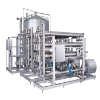Fermenter
Laboratory fermenter operation principle——Regulation of stir
Time:2023.02.28

Stirring is the basic mechanical device of the fermenter, which also benefits the fermentation of microorganisms.The stirring system of laboratory fermenter is divided into motor and gearbox, stirring shaft, stirring paddle, shaft seal and baffles.
The motor and gearbox are to provide power for stirring; the stirring paddle and stirring shaft are the main parts of the operation; the shaft seal is to prevent the fermentation liquid from leaking out and contamination by stray bacteria; the baffle is to prevent large vortex on the liquid surface during stirring and promote the mixing of liquid in the tank.


THE EFFECT OF STIRRING
The basic structure of a stirred tank fermenter is a stirring shaft that extends into the tank at the top or bottom of the tank, and the shaft will be equipped with 2 to 4 stirring paddles.Stirring is to make the materials in the tank can be better mixed, which is conducive to the solid and nutrient contact adequately, facilitating the nutrient absorption and the dispersion of metabolites.In addition, stirring can also evenly disperse the air entering the tank, increasing the air-liquid contact area in the laboratory fermenter and facilitating the mixing of oxygen and fermentation broth.CHOICE OF STIRRING PADDLES
The main structure in the stirring system is the shaft and the paddle, so how to choose the paddle?Different types of stirrer blades produce different axial and radial forces, so it is necessary to choose the right stirrer for different cultures in fermentation process. For example, Rushton stirring paddles are flat blades, which are distributed vertically on the stirring shaft,with a baffle plate when the paddles as the boundary, forming the upper and lower circulation of the flow field, resulting in a large shear force.However, since the flat blades produce only unidirectional flow, the mixing effect is not as good.For these reasons, and with some gas underneath the disc, Rushton and other Rushton type stirring paddles are widely used for the culture of yeast, bacteria, plant cells, etc., which are not sensitive to shear forces in aerobic conditions of cell lines.
About the laboratory fermenter stirring principle, I believe you have a general understanding through this article.Stay tuned to HOLVES, after which we will explain how to solve the problem of foam generated in the tank during fermentation in laboratory fermenter.






